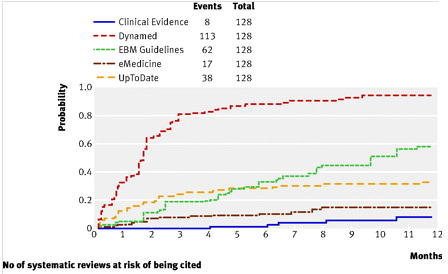![]() Paul Glasziou, GP and professor in Evidence Based Medicine, co-authored a new article in the BMJ [1]. Similar to another paper [2] I discussed before [3] this paper deals with the difficulty for clinicians of staying up-to-date with the literature. But where the previous paper [2,3] highlighted the mere increase in number of research articles over time, the current paper looks at the scatter of randomized clinical trials (RCTs) and systematic reviews (SR’s) accross different journals cited in one year (2009) in PubMed.
Paul Glasziou, GP and professor in Evidence Based Medicine, co-authored a new article in the BMJ [1]. Similar to another paper [2] I discussed before [3] this paper deals with the difficulty for clinicians of staying up-to-date with the literature. But where the previous paper [2,3] highlighted the mere increase in number of research articles over time, the current paper looks at the scatter of randomized clinical trials (RCTs) and systematic reviews (SR’s) accross different journals cited in one year (2009) in PubMed.
Hofmann et al analyzed 7 specialties and 9 sub-specialties, that are considered the leading contributions to the burden of disease in high income countries.
They followed a relative straightforward method for identifying the publications. Each search string consisted of a MeSH term (controlled term) to identify the selected disease or disorders, a publication type [pt] to identify the type of study, and the year of publication. For example, the search strategy for randomized trials in cardiology was: “heart diseases”[MeSH] AND randomized controlled trial[pt] AND 2009[dp]. (when searching “heart diseases” as a MeSH, narrower terms are also searched.) Meta-analysis[pt] was used to identify systematic reviews.
Using this approach Hofmann et al found 14 343 RCTs and 3214 SR’s published in 2009 in the field of the selected (sub)specialties. There was a clear scatter across journals, but this scatter varied considerably among specialties:
“Otolaryngology had the least scatter (363 trials across 167 journals) and neurology the most (2770 trials across 896 journals). In only three subspecialties (lung cancer, chronic obstructive pulmonary disease, hearing loss) were 10 or fewer journals needed to locate 50% of trials. The scatter was less for systematic reviews: hearing loss had the least scatter (10 reviews across nine journals) and cancer the most (670 reviews across 279 journals). For some specialties and subspecialties the papers were concentrated in specialty journals; whereas for others, few of the top 10 journals were a specialty journal for that area.
Generally, little overlap occurred between the top 10 journals publishing trials and those publishing systematic reviews. The number of journals required to find all trials or reviews was highly correlated (r=0.97) with the number of papers for each specialty/ subspecialty.”
Previous work already suggested that this scatter of research has a long tail. Half of the publications is in a minority of papers, whereas the remaining articles are scattered among many journals (see Fig below).
- Click to enlarge en see legends at BMJ 2012;344:e3223 [CC]
The good news is that SRs are less scattered and that general journals appear more often in the top 10 journals publishing SRs. Indeed for 6 of the 7 specialties and 4 of the 9 subspecialties, the Cochrane Database of Systematic Reviews had published the highest number of systematic reviews, publishing between 6% and 18% of all the systematic reviews published in each area in 2009. The bad news is that even keeping up to date with SRs seems a huge, if not impossible, challenge.
In other words, it is not sufficient for clinicians to rely on personal subscriptions to a few journals in their specialty (which is common practice). Hoffmann et al suggest several solutions to help clinicians cope with the increasing volume and scatter of research publications.
- a central library of systematic reviews (but apparently the Cochrane Library fails to fulfill such a role according to the authors, because many reviews are out of date and are perceived as less clinically relevant)
- registry of planned and completed systematic reviews, such as prospero. (this makes it easier to locate SRs and reduces bias)
- Synthesis of Evidence and synopses, like the ACP-Jounal Club which summarizes the best evidence in internal medicine
- Specialised databases that collate and critically appraise randomized trials and systematic reviews, like www.pedro.org.au for physical therapy. In my personal experience, however, this database is often out of date and not comprehensive
- Journal scanning services like EvidenceUpdates from mcmaster.ca), which scans over 120 journals, filters articles on the basis of quality, has practising clinicians rate them for relevance and newsworthiness, and makes them available as email alerts and in a searchable database. I use this service too, but besides that not all specialties are covered, the rating of evidence may not always be objective (see previous post [4])
- The use of social media tools to alert clinicians to important new research.
Most of these solutions are (long) existing solutions that do not or only partly help to solve the information overload.
I was surprised that the authors didn’t propose the use of personalized alerts. PubMed’s My NCBI feature allows to create automatic email alerts on a topic and to subscribe to electronic tables of contents (which could include ACP journal Club). Suppose that a physician browses 10 journals roughly covering 25% of the trials. He/she does not need to read all the other journals from cover to cover to avoid missing one potentially relevant trial. Instead it is far more efficient to perform a topic search to filter relevant studies from journals that seldom publish trials on the topic of interest. One could even use the search of Hoffmann et al to achieve this.* Although in reality, most clinical researchers will have narrower fields of interest than all studies about endocrinology and neurology.
At our library we are working at creating deduplicated, easy to read, alerts that collate table of contents of certain journals with topic (and author) searches in PubMed, EMBASE and other databases. There are existing tools that do the same.
Another way to reduce the individual work (reading) load is to organize journals clubs or even better organize regular CATs (critical appraised topics). In the Netherlands, CATS are a compulsory item for residents. A few doctors do the work for many. Usually they choose topics that are clinically relevant (or for which the evidence is unclear).
The authors shortly mention that their search strategy might have missed missed some eligible papers and included some that are not truly RCTs or SRs, because they relied on PubMed’s publication type to retrieve RCTs and SRs. For systematic reviews this may be a greater problem than recognized, for the authors have used meta-analyses[pt] to identify systematic reviews. Unfortunately PubMed has no publication type for systematic reviews, but it may be clear that there are many more systematic reviews that meta-analyses. Possibly systematical reviews might even have a different scatter pattern than meta-analyses (i.e. the latter might be preferentially included in core journals).
Furthermore not all meta-analyses and systematic reviews are reviews of RCTs (thus it is not completely fair to compare MAs with RCTs only). On the other hand it is a (not discussed) omission of this study, that only interventions are considered. Nowadays physicians have many other questions than those related to therapy, like questions about prognosis, harm and diagnosis.
I did a little imperfect search just to see whether use of other search terms than meta-analyses[pt] would have any influence on the outcome. I search for (1) meta-analyses [pt] and (2) systematic review [tiab] (title and abstract) of papers about endocrine diseases. Then I subtracted 1 from 2 (to analyse the systematic reviews not indexed as meta-analysis[pt])
Thus:
(ENDOCRINE DISEASES[MESH] AND SYSTEMATIC REVIEW[TIAB] AND 2009[DP]) NOT META-ANALYSIS[PT]
I analyzed the top 10/11 journals publishing these study types.
This little experiment suggests that:
- the precise scatter might differ per search: apparently the systematic review[tiab] search yielded different top 10/11 journals (for this sample) than the meta-analysis[pt] search. (partially because Cochrane systematic reviews apparently don’t mention systematic reviews in title and abstract?).
- the authors underestimate the numbers of Systematic Reviews: simply searching for systematic review[tiab] already found appr. 50% additional systematic reviews compared to meta-analysis[pt] alone
- As expected (by me at last), many of the SR’s en MA’s were NOT dealing with interventions, i.e. see the first 5 hits (out of 108 and 236 respectively).
- Together these findings indicate that the true information overload is far greater than shown by Hoffmann et al (not all systematic reviews are found, of all available search designs only RCTs are searched).
- On the other hand this indirectly shows that SRs are a better way to keep up-to-date than suggested: SRs also summarize non-interventional research (the ratio SRs of RCTs: individual RCTs is much lower than suggested)
- It also means that the role of the Cochrane Systematic reviews to aggregate RCTs is underestimated by the published graphs (the MA[pt] section is diluted with non-RCT- systematic reviews, thus the proportion of the Cochrane SRs in the interventional MAs becomes larger)
Well anyway, these imperfections do not contradict the main point of this paper: that trials are scattered across hundreds of general and specialty journals and that “systematic reviews” (or meta-analyses really) do reduce the extent of scatter, but are still widely scattered and mostly in different journals to those of randomized trials.
Indeed, personal subscriptions to journals seem insufficient for keeping up to date.
Besides supplementing subscription by methods such as journal scanning services, I would recommend the use of personalized alerts from PubMed and several prefiltered sources including an EBM search machine like TRIP (www.tripdatabase.com/).
*but I would broaden it to find all aggregate evidence, including ACP, Clinical Evidence, syntheses and synopses, not only meta-analyses.
**I do appreciate that one of the co-authors is a medical librarian: Sarah Thorning.
References
- Hoffmann, Tammy, Erueti, Chrissy, Thorning, Sarah, & Glasziou, Paul (2012). The scatter of research: cross sectional comparison of randomised trials and systematic reviews across specialties BMJ, 344 : 10.1136/bmj.e3223
- Bastian, H., Glasziou, P., & Chalmers, I. (2010). Seventy-Five Trials and Eleven Systematic Reviews a Day: How Will We Ever Keep Up? PLoS Medicine, 7 (9) DOI: 10.1371/journal.pmed.1000326
- How will we ever keep up with 75 trials and 11 systematic reviews a day (laikaspoetnik.wordpress.com)
- Experience versus Evidence [1]. Opioid Therapy for Rheumatoid Arthritis Pain. (laikaspoetnik.wordpress.com)
Related articles
- Can Guidelines Harm Patients? (laikaspoetnik.wordpress.com)
- Plausibility bias? You say that as though that were a bad thing! (sciencebasedmedicine.org)
- “Plausibility bias”? Try “reality bias” when it comes to clinical trials. [Respectful Insolence] (scienceblogs.com)
- Connecting Researchers to Unpublished Research (semanticweb.com)
- Systematic review / synthesis of qualitative evidence – issues (phtwitjc.wordpress.com)










































Recent Comments